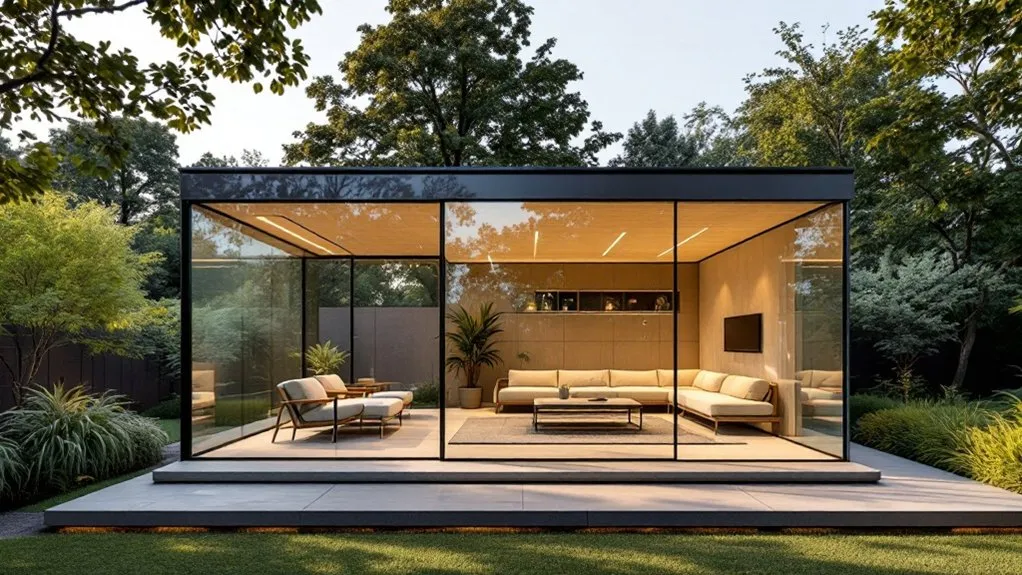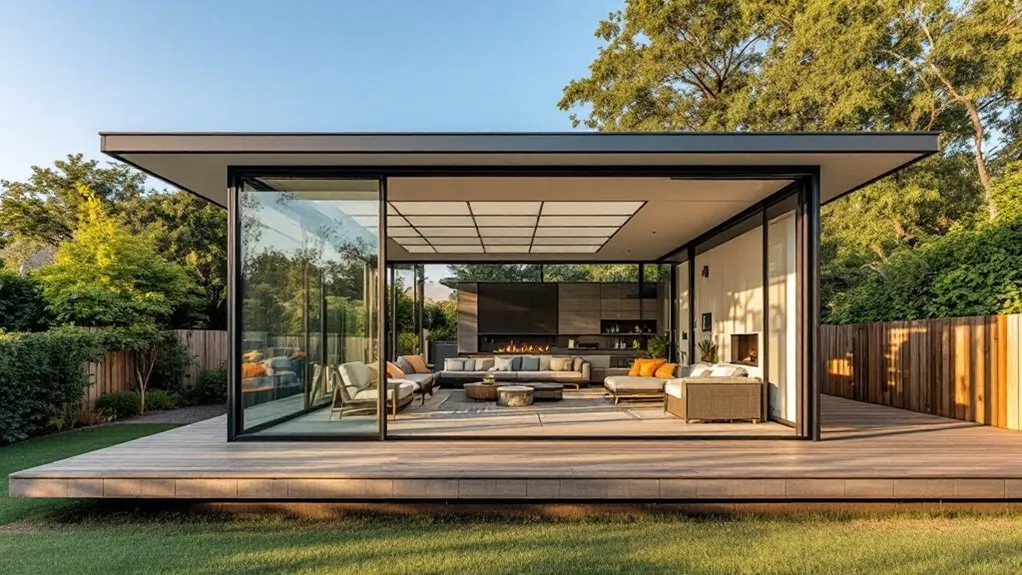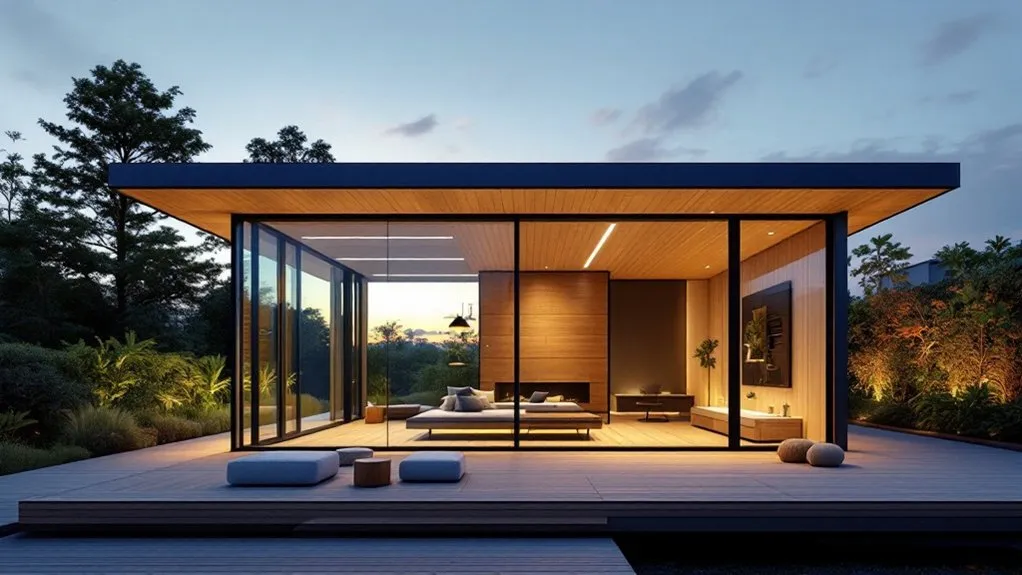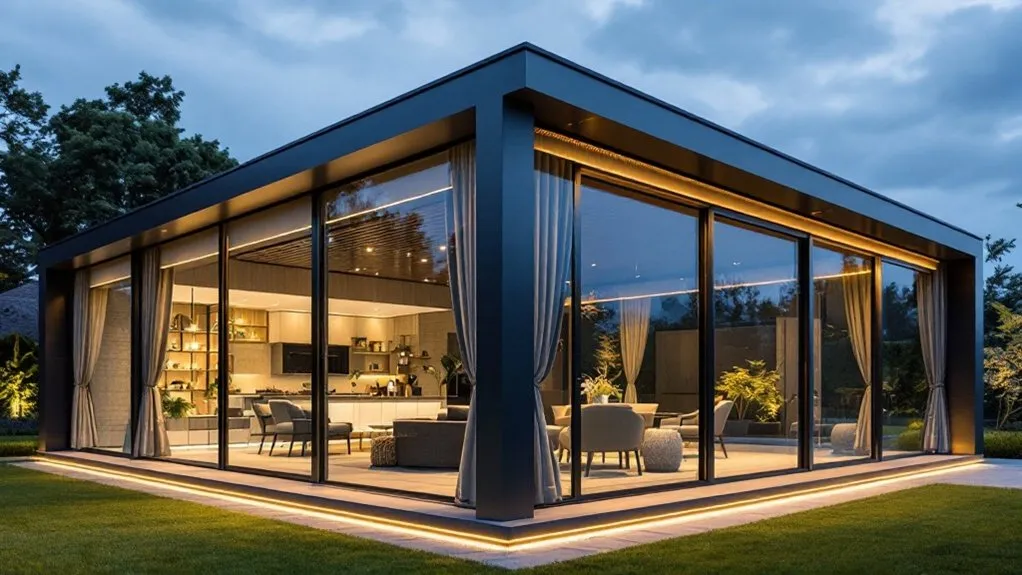Modern pavilion designs for 2025 will transform your outdoor living with integrated innovative technology and sustainable materials. You’ll control lighting, climate, and entertainment through mobile apps or voice commands, while recycled composites and solar-integrated structures reduce environmental impact. Climate-controlled spaces feature infrared heating, misting systems, and smart ventilation for year-round comfort. The modular components enable flexible configurations for multiple uses, from dining to workspaces. Exploring these innovations reveals how pavilions are evolving into sophisticated multi-functional environments.
Key Takeaways
- Smart home integration enables complete control of pavilion environments through mobile apps featuring automated climate systems and customizable lighting settings.
- Eco-conscious materials, including recycled composites and living roofs, prioritize sustainability while maintaining structural integrity and aesthetic appeal.
- Modular designs with quick-connect components allow spaces to transform rapidly between dining areas, workspaces, and entertainment zones.
- Climate-controlled outdoor spaces utilize integrated heating, misting systems, and smart ventilation to maintain comfort throughout varying weather conditions.
- Luxury entertainment pavilions combine weatherproof audio-visual systems with high-end outdoor kitchens for sophisticated open-air living experiences.
Smart Technology Integration in Modern Pavilions

As pavilion design evolves into 2025, smart technology integration has become a cornerstone of modern outdoor structures.
You’ll find cutting-edge smart home automation systems that seamlessly control lighting, climate, and audio-visual elements through mobile apps or voice commands. Integrated security systems now feature motion sensors, HD cameras, and biometric access controls for open-air environments.
Your pavilion’s tech infrastructure can include weather-responsive retractable roofing, automated sun shades, and smart glass that adjusts its opacity based on sunlight intensity.
These systems communicate with each other through a centralized hub, optimizing your comfort while minimizing energy consumption.
Sustainable Materials and Eco-Friendly Features
Sustainable pavilion construction 2025 will prioritize recycled composite materials that combine post-consumer plastics with reclaimed wood fibers for superior durability and minimal environmental impact.
You’ll find integrated living roof systems incorporating drought-resistant vegetation and smart irrigation controls, effectively reducing heat island effects while managing stormwater runoff.
Solar-integrated shade structures will feature thin-film photovoltaic panels seamlessly embedded within the pavilion’s overhead elements, generating clean energy while providing essential shade protection.
Recycled Composite Building Materials
Leading the transformation in pavilion construction, recycled composite building materials have emerged as a cornerstone of sustainable design for 2025. These material innovations revolutionize outdoor structures through advanced polymer blends and repurposed industrial waste.
| Material Type | Performance Metrics |
|---|---|
| rPET Composites | 85% tensile strength |
| Recycled HDPE | 25-year lifespan |
| Bio-composites | 90% carbon reduction |
| Fiber-reinforced | 40% weight savings |
| Hybrid polymers | 70% energy efficient |
These sustainability practices deliver superior durability while minimizing environmental impact. You can expect enhanced weather resistance, reduced maintenance requirements, and structural integrity that rivals traditional materials, all while supporting circular economy initiatives.
Living Green Roof Systems
Building upon the advancements in composite materials, living green roof systems represent the next evolution in pavilion design for 2025.
These sustainable installations incorporate drought-resistant sedum varieties and native plant species, enhancing urban biodiversity while providing natural insulation.
The modular green roof benefits include reduced heat island effect, improved stormwater management, and extended roof membrane lifespan.
Your pavilion’s system will feature lightweight growing medium (10-15 cm depth), root barriers, and automated irrigation controls.
The design integrates water retention cells, ensuring ideal plant health during dry periods while managing excess rainfall through controlled release mechanisms.
Solar-Integrated Shade Structures
As photovoltaic technology advances, integrated solar shade structures emerge as a cornerstone of 2025’s pavilion designs.
These dual-purpose installations deliver ideal solar efficiency while providing robust shade durability through advanced composite materials. The structures incorporate bifacial solar panels that capture direct and reflected sunlight, maximizing energy generation.
- Tempered glass panels with prismatic light-filtering technology
- Self-cleaning hydrophobic surface treatments
- Load-bearing carbon fiber support systems
- Smart-tinting electrochromic glazing
- Weather-responsive automated positioning mechanisms
These intelligent shade systems adapt to environmental conditions, automatically adjusting their angle for maximum energy collection while maintaining ideal shade coverage.
You’re getting peak performance in both power generation and climate control functionality.
Climate-Controlled Outdoor Living Spaces

Modern pavilion designs increasingly incorporate sophisticated climate control systems that transform outdoor structures into year-round living spaces.
You’ll find integrated heating elements, misting systems, and intelligent ventilation controls that optimize comfort in varying weather conditions. These innovations create seamless indoor-outdoor exchanges while maintaining ideal temperatures.
The latest climate adaptability features include infrared heaters mounted discreetly in overhead beams, retractable screens with thermal properties, and automated air circulation systems.
You can program these components through smart devices, adjusting environmental parameters based on weather data. Zoned climate management allows for multiple comfort settings within a single pavilion space.
Biophilic Design Elements and Natural Integration
Natural aesthetics and environmental integration shape the next evolution in pavilion design, extending beyond climate control to embrace biophilic principles.
Nature-inspired aesthetics seamlessly merge with architectural elements, creating a harmonious indoor-outdoor flow that connects you to the surrounding landscape.
- Living walls with Indigenous climbing plants integrating structural supports.
- Translucent roof panels embedding natural leaf patterns and organic textures
- Locally sourced stone and reclaimed wood materials reflecting regional ecology
- Curved architectural forms mimicking natural growth patterns
- Bio-retention systems incorporating native plant species around perimeter drainage
These biophilic design elements maximize psychological well-being while maintaining structural integrity and functionality, establishing pavilions as natural extensions of their environment.
Modular and Transformable Pavilion Structures

Modern pavilion specifications now prioritize modular components you’ll configure into multiple spatial arrangements, maximizing the structure’s adaptability for varied functions.
You can transform these adaptable systems through quick-connect joints, telescoping elements, and standardized panels that integrate seamlessly with pre-engineered foundation systems.
The modular framework’s rapid assembly protocol enables you to deploy the structure within compressed timeframes while maintaining strict quality control parameters across all configurational variations.
Multi-Purpose Space Solutions
As pavilion design evolves into 2025, adaptable structures featuring modular components and transformable elements are revolutionizing outdoor space utilization.
You’ll find flexible layouts that seamlessly convert from dining areas to workspace configurations, while functional furniture adapts to your changing needs throughout the day.
- Sliding wall panels that create instant private meeting pods
- Height-adjustable canopies with integrated climate control
- Multi-level platforms transforming from seating to display areas
- Retractable dividers enabling space partitioning
- Smart storage solutions built into structural elements
These intelligent design solutions maximize your pavilion’s versatility while maintaining aesthetic appeal and operational efficiency.
The integration of transformable elements guarantees your space serves multiple purposes without compromise.
Quick Assembly Design Features
While traditional pavilion construction often requires extensive on-site labor, 2025’s quick-assembly designs incorporate precision-engineered components that reduce installation time by up to 70%.
You’ll find lightweight composite panels with integrated locking mechanisms that snap together without specialized tools. The innovative materials include aerospace-grade aluminum alloys and carbon fiber reinforcements, offering superior strength-to-weight ratios.
The system’s modular framework features pre-coded connection points and self-aligning joints. You can reconfigure these components using digital assembly guides through augmented reality interfaces.
Each section’s weather-resistant seals activate automatically during assembly, ensuring immediate weather protection without additional caulking or weatherproofing steps.
Luxury Entertainment and Outdoor Kitchen Pavilions
Luxury entertainment pavilions have evolved into sophisticated outdoor living spaces that seamlessly integrate professional-grade kitchen equipment with high-end audiovisual systems.
These structures now incorporate weatherproof luxury furnishings and dedicated zones for outdoor dining, creating versatile entertainment hubs.
- 304-grade stainless steel appliances with precision temperature controls
- Integrated 4K weatherproof displays with surround sound systems
- Smart lighting with programmable ambient settings
- Climate control systems with retractable walls and roof panels
- Built-in wine refrigeration and temperature-controlled storage units
These pavilions feature commercial-grade ventilation systems, ensuring smoke-free cooking environments while maintaining ideal air circulation.
Advanced automation systems let you control all functions through a centralized interface.
Weather-Resistant and All-Season Solutions

Modern pavilion designs prioritize year-round functionality through advanced weather-resistant technologies and adaptable structural elements.
You’ll find innovative solutions like retractable polycarbonate roofing systems that offer excellent weather protection while maintaining natural light penetration. Automated side panels with weather sensors adjust to changing conditions, ensuring comfort in any season.
The latest pavilion designs incorporate dual-layered insulation materials and smart climate control systems for enhanced seasonal adaptability.
These features include integrated heating elements, UV-resistant surfaces, and moisture-managing ventilation systems. You can now customize your pavilion’s environmental settings through smartphone-connected controls, maximizing usability throughout the year.
Frequently Asked Questions
What Permits Are Typically Required for Installing a Residential Pavilion?
You’ll need to obtain several key permits before installing a residential pavilion.
Start with approval of local zoning regulations to verify setback requirements and property line restrictions.
Next, secure construction permits, typically building, electrical (if applicable), and foundation permits.
You must also submit detailed architectural drawings, site plans, and structural calculations.
Check with your municipality’s building department, as requirements vary by jurisdiction.
How Long Does a Custom Pavilion Installation Usually Take?
Custom pavilion installation timelines typically range from 3-10 days, depending on your customization options and project complexity.
The process includes site preparation (1-2 days), foundation work (1-3 days), and structure assembly (1-5 days).
If you’re incorporating electrical components, specialty roofing, or unique architectural elements, you must add 2 to 3 extra days.
Weather conditions and material availability can also impact your installation schedule.
Can Existing Patios Be Converted Into Pavilion Spaces?
You can convert your existing patio into a pavilion space through strategic patio transformation techniques.
The process requires evaluating your current foundation’s load-bearing capacity, structural integrity, and footprint dimensions.
You must assess local building codes, determine post-mounting options, and guarantee proper drainage systems.
The outdoor aesthetics can be maintained by integrating complementary roofing materials and architectural elements that align with your home’s design features.
What Is the Average Lifespan of a Modern Outdoor Pavilion?
You’ll find that a modern outdoor pavilion’s lifespan depends primarily on pavilion materials and maintenance quality.
With premium materials like treated hardwood or powder-coated aluminum, you can expect 20-30 years of service. Lifespan factors include weather exposure, structural integrity, and routine upkeep.
Steel frameworks typically last 30-40 years, while high-grade composites can exceed 50 years.
You must factor in climate conditions and usage intensity for accurate longevity predictions.
How Much Maintenance Do Pavilion Structures Require Throughout the Year?
You’ll need to maintain your pavilion’s materials regularly throughout the year. You must monitor snow loads and evident accumulation during winter.
For wooden structures, you should conduct quarterly inspections, annual sealing or staining, and periodic checks for rot or pest infestation.
Metal pavilions require bi-annual rust prevention and connection tightening.
Your seasonal upkeep should include gutter cleaning, roof inspection, and debris removal.
During winter, you must monitor snow loads and evident accumulation to prevent structural stress.

